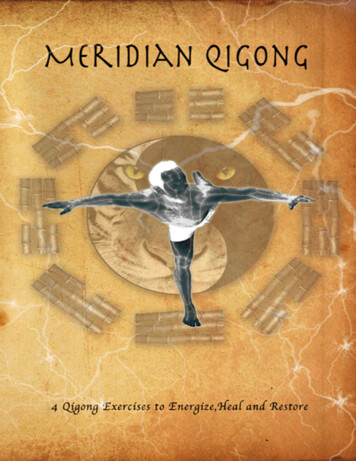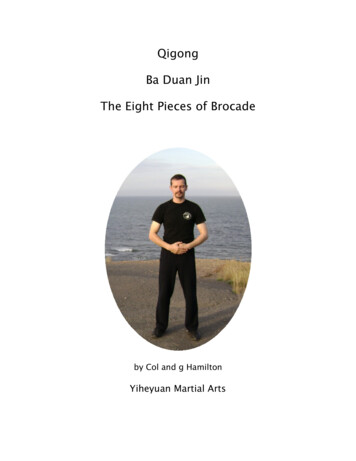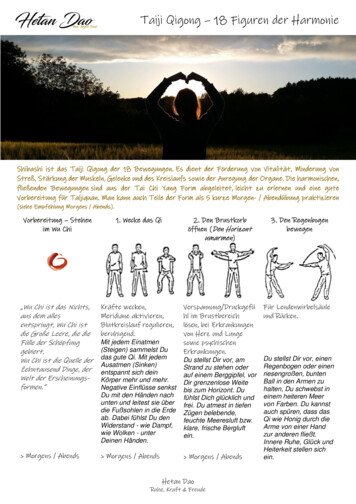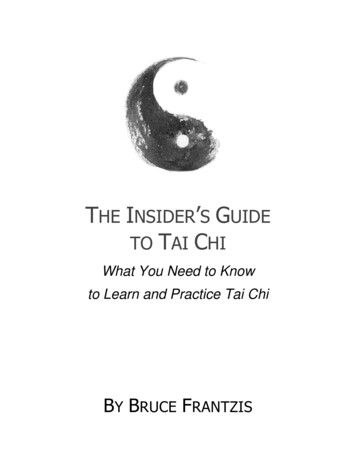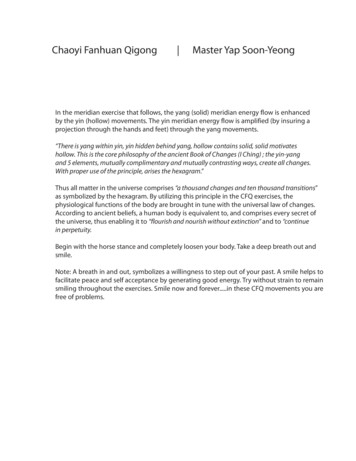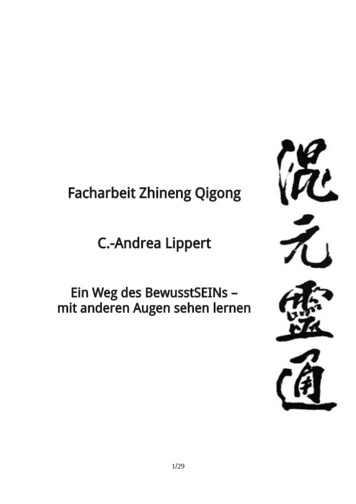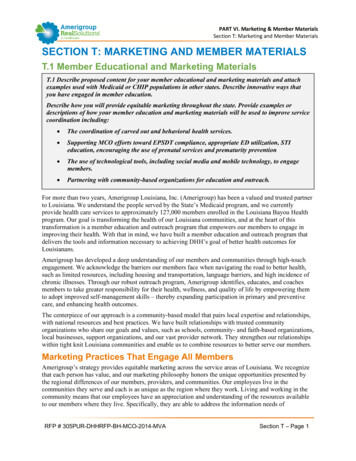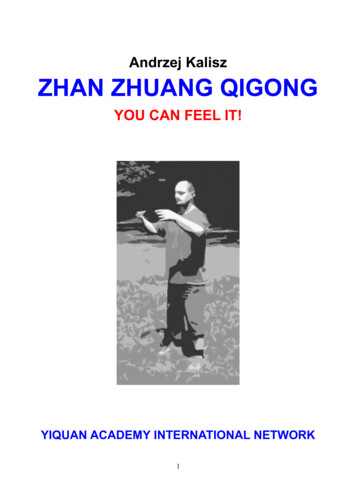
Transcription
Andrzej KaliszZHAN ZHUANG QIGONGYOU CAN FEEL IT!YIQUAN ACADEMY INTERNATIONAL NETWORK1
I would like to express gratitude to:My parents.Thanks to their help I could enter the path of studying Chinese culture, martial artsand exercises for cultivating health.My teacher Yao Chengguang.He helps me to research the principles of studying and experiencing, and isgenerously sharing his own experience gained by 50 years of practice.My students.They appreciate my efforts and their progress makes me sure that what I’m studyingand passing to them is valuable.Andrzej Kalisz2
This is because health, well-being, seeking beauty, balance and harmony are important in humanlife, that such forms of exercises like yoga, tai chi and chi kung have became very popular all overthe world. But until recently yiquan and zhan zhuang were not widely known. Now they are rapidlybecoming popular.Some people say that zhan zhuang is a Chinese yoga. Wide use of positionalexercises resembles use of asana in Indian yoga.Zhan zhuang is often classified as a method of qigong (in broad meaning). It hasbeen used as a supplemental means of therapy in hospitals in China since 1950s.Tai chi of 21st century – this is another term used in relation to zhan zhuang andyiquan. Presently many taijiquan instructors are including zhan zhuang method intheir curriculum or are switching from taijiquan to yiquan.3
CONTENTSChapter IRELAX FIRST-5-8-Zhan zhuang and yiquanChapter IIUSING IMAGINATION- 10 - 15 -On qigongChapter IIIFOCUSING MIND- 18 - 20 -On meditationChapter IVBODY AWARENESS- 21 - 25 -Sensations and body reactionsChapter VRELAX AND EFFORT- 27 - 30 -In search of harmonyChapter VIDIRECTING STRENGTHOn Tai ChiChapter VIITESTING STRENGTH- 37 - 41 -On internal artsChapter VIIIMORE ON TESTING STRENGTHQi – magic power?Chapter IXFRICTION STEPSChapter XI- 43 - 47 - 50 - 57 -PhilosophyChapter X- 31 - 36 -THERAPYHow does it work?- 59 - 62 -BEYOND BASICS- 64 -SUGGESTED LITERATURE ON ZHAN ZHUANG- 67 -YIQUAN TRAINING WORLDWIDE SUPPORT- 68 -4
Chapter IRELAX FIRST5
Relaxation is what most people interested in starting study of qigong, taijiquan (tai chi) or yoga arelooking for. Relaxation is also one of the most important issues in practice of zhan zhuang method.Many adult people have developed excessive habitual tension of some muscles. This is in big part aresult of accumulating stresses which are part of life of modern people. Sometimes it can be verydifficult to get rid of tension and stiffness. Excessive tension will make doing various actions inwork or in everyday life more difficult, will exhaust you physically and mentally. Even when youare trying to relax, sitting in an armchair, very often you are still too tense. In many cases yourshoulders are raised, neck and face stiff.Now stand in natural, relaxed position, with your feet shoulder-width apart and toes slightlypointing outward. You can do some slight, free movements. This will help you to check whetheryou are not too tense, because too much tension of muscles is reflected in stiffness, in limitation offree movement of your joints. You can repeat it many times in this or some other position or whilewalking. Don’t try too hard, don’t concentrate too much. Do it in a bit casual, careless manner. Thisway you will gradually learn how to eliminate tension and you will be more conscious of whetheryou are relaxed or tense. You can use this method before doing next exercises.You could also use a method of careful observing the level of tension and conscious relaxing yourbody part by part. First think about your head. If you will notice some feeling of tension there, try toremove it slowly. Then shift your attention to neck, observing the level of tension and slowly,without haste or trying too hard, relax it. Keep shifting attention gradually lower and lower, towardyour chest, upper back and upper arms, then waist, abdomen, elbows and forearms, then lowerabdomen, buttocks, wrists, palms, thighs, shanks, feet, all the time observing the level of tensionand gradually relaxing your body. You can repeat this cycle many times.This way you are gradually relaxing your body, eliminating tension. And because your mind isengaged in this process, you become more focused, all disturbing thoughts are becoming weaker.You are becoming more relaxed both physically and mentally.Zhan zhuang method is based on using intention, working on co-ordination between mind and body.This aspect will be included in all further described exercises.Sometimes even realizing the tension can be difficult. In such a case you can first try to make someparts of your body very tense, and only then to relax them, all the time observing sensations whichyou experience very carefully. This will help you to develop better perception and ability ofdistinguishing the states of relax and tension.Also when you are aware that some part of your body is too tense, but you are not able to relax it,you can try first to tense it even more and only then to relax. If you will not achieve good effectsimmediately, don’t worry, just repeat it regularly, without trying too hard, a bit casually. Progresswill come with time, and results will become deeper gradually. And if you try too hard, it could6
make you more tense.One of the aspects of relax is a natural, freely flowing breath. If there appears some tension in thearea of your chest and abdomen, it will disturb breathing. If you notice this kind of problems, takecare to check if it is not related to such tension. Then try to relax the tense area, so your chest andabdomen will be able to move freely again, and you will notice that your breathing becomes morefree. Don’t try too hard. Don’t concentrate on controlling breathing. Just let the natural mechanismswork.When you practice zhan zhuang, there is no need for special place, time or clothes. You can do theexercises in various situations: standing, sitting, lying on bed, walking, doing various actions. But ifyou have chance, try to practice in a park, in woods, in natural surroundings with free air. This isnot advised to practice when your are very hungry or very full. Before starting practice, you shouldgo to toilet. Unfasten some buttons, make your belt loose, so you can feel comfortable whilepracticing.Gradually you will find more and more pleasure in doing exercises and the practice sessions willnaturally become longer, there will be no need to force yourself to practice. But at beginning youcan start from just a few minutes, practicing everyday, several times per day if it’s possible, forexample during breaks in work or any other times. It is better to make practice session shorter andmore frequent, keeping the pleasant feeling of comfort while doing exercise, not trying to make thepractice sessions very long at beginning. But don’t stop doing exercise immediately when feel likeit – first think for a moment if you are really tired or if it is just kind of impatience (in such case tryto keep practicing with calm mind).After finishing practice session, start moving slowly and have a look around. You can make a fewdeeper breaths, exhaling in a way as if sighing out. You can shake your body slightly or do someself-massage.When you will already have some experience with zhan zhuang, and you will be able to adjusttime and intensity of practice properly, you will feel relaxed and full of energy after doingexercises and you will wake up fresh next morning.7
ZHAN ZHUANG AND YIQUAN"The sages of ancient times used to stand on earth, supporting heaven, controlling yin and yang,breathing with essence of qi, standing alone, guarding spirit, with body being a one".This quote from "Yellow Emperor's Inner Classics" (from about 3rd century B.C.) is by manyresearchers seen as the earliest mention about zhan zhuang. However this method of cultivatinghealth became really popular only in 20th century.Some exercises known as zhan zhuang used to be utilized by most of traditional Chinese martialarts. But in many cases their function was just strengthening legs to achieve stronger, more stablepostures in combat. In these cases there is almost no relation between such zhan zhuang and themethod described in this book.Zhan zhuang exercises described here, which are being used in Chinese hospitals and sanatoria assupplemental method of therapy, and are also practiced by many people with aim of improvinghealth and promoting well being, were developed by famous master Wang Xiangzhai (1885-1963).As a young child Wang Xiangzhai became student of Guo Yunshen, who was one of the most famousmasters in history of xingyiquan (hsing-I ch’uan) – one of Chinese internal martial arts. As in manyxingyiquan schools zhan zhuang exercises are limited only to santishi posture, it is not quite clearwhether Wang learned more of zhan zhuang postures as part of “secret transmission” or if hedeveloped them later by himself on basis of santishi.Wang Xiangzhai traveled a lot all over China, meeting many experts of traditional martial arts andexercises for cultivating health. This way he gained a lot of experience. In middle 1920s he starteddeveloping his own variant of xingyiquan, which he called yiquan. Zhan zhuang exercises becamethe most characteristic and stressed part of training. On turn of 1920s and 1930s Wang Xiangzhaibecame very famous in Shanghai.It was period of strong influence of western culture and science in China, and hence some criticismtoward Chinese tradition. Wang had met many famous representatives of various schools in allparts of China. He was able to notice that not everything in tradition was really valuable, thatfollowing old ways without any criticism may cause a lot of bad results. Impact of western sciencewas important factor which inspired him to try to view traditional concepts and methods fromdifferent perspective. His goal was keeping what was valuable in traditional systems, and gettingrid of what was wrong. This opened a way for further verification of methods and modifyingtheories.By end of 1930s Wang Xiangzhai moved to Beijing, which became the main center of yiquan sincethen. In 1940s his system was also promoted by his students as dachengquan. This name is still8
used by some branches of the system.When yiquan became a famous martial art, many practitioners could personally discover, thatpracticing zhan zhuang helps to improve health. In 1940s more and more people started practicingyiquan (dachengquan) mainly to cultivate health. And in 1950s situation was not favorable forpopularizing an efficient art of combat. So Wang concentrated more on using zhan zhuang as amethod of therapy. He was working in hospitals in Beijing and later in Baoding. Such variant ofyiquan, limited to most basic methods, became quite popular. And complete system was practicedby very few people. Only since 1980s yiquan (dachengquan) taught as a complete art could bepopularized again officially.The system of cultivating health exercises developed by Wang Xiangzhai is usually called zhanzhuang, because standing postures are most often used. However also sitting postures, lying on bedpostures, half supported postures and moving exercises are used. Those whose health and level offitness doesn’t limit the possibility of practicing more advanced methods, use to practice yiquan as acomplete art.Chinese charactersInternational transcriptionOld English transcription站桩Zhan zhuangChan chuang意拳YiquanI ch’uan王芗斋Wang XiangzhaiWang Hsiang-chai9
Chapter IIUSING IMAGINATION10
While doing zhan zhuang exercises, you can use various imaginations, which will help you inachieving the state of relax, comfort and feeling elastic force. You don’t need to try to learn andmaster many various images. These are only a tool which you can use if they are really helpful. Souse them according to actual needs.Various methods can be more or less useful for various people. Everybody knows himself/herselfand knows what helps him/her to become relaxed. According to this personal knowledge,appropriate imaginations or suggestions can be chosen.For example, if it is easy for you to relax while you are listening to some specific piece of music,you can think about hearing this music, trying to remember how you usually feel when you arelistening to it. You don’t need and you should not think about it all the time. Just use it as a tool,when there is a need. When you achieve result, don’t stick to the method.If you felt relaxed and comfortable in some place or situation, just try to remember it. If you get thisfeeling of relax and comfort, you don’t need to think about the place or situation all the time. Justfocus on perceiving the state of relax and comfort.Don’t think about exercise as something you must do, but something which you find pleasant. Zhanzhuang is training while resting, resting while training. For example you can think that you arehaving a stroll in a park, being pleasantly relaxed, in good mood. You are watching beautiful views,enjoying the sound of birds singing and scent of flowers. During the stroll you are casuallyassuming some posture, because you feel like it, because you find the posture comfortable. Whilestanding you are relaxed, feeling soft, elastic unity of whole body. Slight breeze is moving yourhair, your clothes. You are feeling so relaxed and soft, that air is as if moving through pores in yourskin.You can imagine that you are taking shower. Water drops are falling on your body and slowlyflowing down are massaging surface of your body. Then imagine that your body becomes so muchrelaxed, that water is able to permeate through it, as if through a sponge, dissolving all tensioninside.Or imagine that your body is as if floating in water, and you don’t need any effort to keep theposture. Water is moving slightly, massaging your body and moving it. Breath is flowing freely andnaturally. You can imagine that your body is like a sponge, water permeating through it, dissolvingall tension which appears the
exercises resembles use of asana in Indian yoga. Zhan zhuang is often classified as a method of qigong (in broad meaning). It has been used as a supplemental means of therapy in hospitals in China since 1950s. Tai chi of 21st century – this is another term used in relation to zhan zhuang and yiquan. Presently many taijiquan instructors are .
